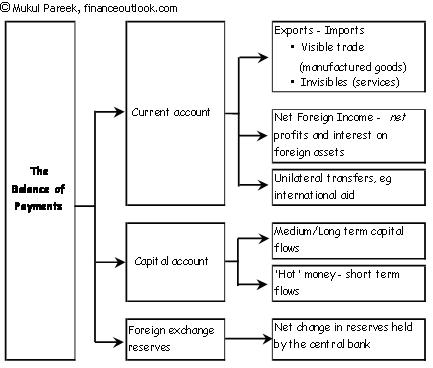- Inflow = Credit
- Outflow = Debit
- Balance of payments is divided into 3 accounts
- Current account
- Capital/financial account
- Official reserves account
Double Entry Bookkeeping
- Every transaction in the balance of payments is recorded twice in accordance with standard accounting practice
- Ex. U.S. manufacturer, John Deere, exports $50 mil worth of farm equipment to Ireland
- Credit of $50 mil to current account
- (- (minus) $50 mil worth of equipment/assets)
- Debit of $50 mil to capital financial account
- (+ $50 mil worth of euros or financial assets
- The two transactions offset each other. Theoretically, the balance payments should always equal zero
Current Account
- Balance of Trade or Net Exports
- Exports of goods/services - import of goods/services
- Exports create a credit to BOP
- Imports create a debit to BOP
- Net Foreign Income
- Income earned by US owned foreign assets
- Ex. Interest payments on US owned Brazilian bonds - interest payments on German owned US Treasury bonds
- Net Transfer (unilateral)
- Foreign aid ---> Debit to current account
- Ex. Mexican migrant workers send money to family in Mexico
- The balance of capital ownership
- Includes purchase of both real and financial assets
- The current account and capital account should zero each other out
- Current Account has negative balance (deficit), Capital Account should have positive balance (surplus)
Official Reserves
- The foreign currency holdings of the U.S. Fed
- When there is a balance of payments surplus the Fed accumulates foreign currency and debits the BOP
- When there is a balance of payments deficit the Fed depletes its reserves of foreign currency and credits the BOP
- Official Reserves zero out the BOP
- The U.S. is passive in its use of official reserves. It does not seem to manipulate the dollar exchange rate
- China is active in its use of official reserves. It actively buys and sells dollars in order to maintain a steady exchange rate with the U.S.

No comments:
Post a Comment